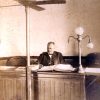calsfoundation@cals.org
Ashley County Lynching of 1857
Prior to the Civil War, most lynchings in Arkansas and across the nation (particularly on the frontier) took the form of vigilante justice, usually to punish white criminals or Southern abolitionists. Although there are newspaper reports of the lynching of four slaves in Saline County, Missouri, in 1859 and reports of a group of slaves accused of fomenting rebellion in North Texas in 1860, slaves were the legal property of their owners. The murder of a slave by someone other than his or her master resulted in a loss of property, which the master presumably wanted to avoid. However, there were instances in which the white community insisted on executing miscreant slaves rather than preserving the owner’s property.
There was at least one antebellum slave lynching in Arkansas. It occurred in September 1857, near the town of Berlin in Ashley County. On October 17, the Washington DC Evening Star, quoting the Bastrop (Texas) Advertiser, reported that the widow Hill, who lived near Berlin, and an unidentified slave woman were murdered by two African-American men, who then set the house on fire and burned the bodies. Several days later, two Black men were burned alive by local citizens; at least one of the men had confessed.
Corydon E. Fuller, who was traveling through Ashley County selling atlases at the time, provides additional information in his diary. On October 10, he recorded that the events occurred three or four weeks prior to that date. In entries written that day and November 14, he explained that the African-American woman who was killed was a slave belonging to a Mr. May, with whom Fuller stayed in November. The slaves who were burned for the crime, Jack and Ike, belonged to Mr. Norrell and Mr. Perdue, respectively. (Fuller’s diary did not give full names, but there was an Isaac F. Norrell and an M. G. Perdue, both slaveowners, living in the county in 1860.) According to Fuller, May was “the principal actor in lynching the slaves,” and Jack proclaimed his innocence throughout, even “with the flames ten feet above his head.”
On November 5, the Holmes County Republican gave a much more complete account of the incident. The Republican reported that Hill was alone and sick, and her neighbor, J. L. May, sent a slave woman to take care of her. Several days later, a white man named Miller and two slaves entered the house, violated the widow “by the indulgence of their hellish appetites,” and then murdered her. The Black woman tried to escape but was killed before she could leave the property. Her body was returned to the house, which the murderers then set on fire.
The following day, all of the area’s slaves were brought together, ostensibly to work on the roads, but actually in an attempt to discover the perpetrators. One of the slaves apparently panicked, mounted his master’s horse, and escaped. He was captured the following day and confessed, naming Miller and the other slave as accomplices. Two days later, according to the Republican, “in the presence of the excited multitude, and upon the spot where the murder was committed” the two slaves were burned at the stake. Miller was present at the lynching, and the slave who had confessed “told him to his face that he was guilty and even from the very flames reproached him with having been the cause of the horrible deed” According to Fuller’s diary, Miller was later chased down and presumably murdered: “At least, no one doubts their having taken his life, and in fact, they do not deny having found him.”
According to the Republican, “The excitement has spread all over the country, and fears are entertained that some difficulty may grow out of the transaction between the owners of the negroes and the parties acting in the premises.” The report concluded by calling the events “a specimen of Southern brutality and cruelty.” Fuller came to a similar conclusion, declaring that “Barbarism is not yet extinct in happy Christianized America; there is still territory for the labors of the Missionary even in the state of Arkansas.”
For additional information:
“Horrible Tragedy in Arkansas.” Evening Star (Washington DC), October 17, 1857, p. 3.
Journal of Corydon E. Fuller, 1856–1859, pp. 28, 47–48. William L. Clements Library, University of Michigan, Ann Arbor, Michigan.
“Two Negroes Burned.” Holmes County (Ohio) Republican, November 5, 1857, p. 1.
Nancy Snell Griffith
Clinton, South Carolina







Comments
No comments on this entry yet.